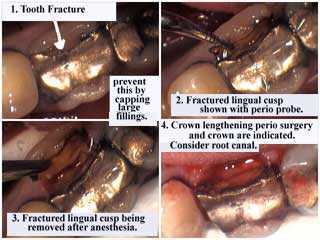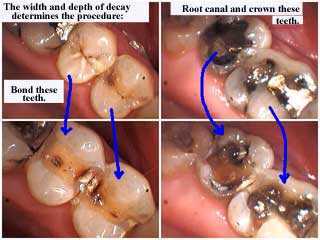Before and after photos help to compare bonding and crowns. All of this work was performed in our Cosmetic Dentistry office.

Compare bonding and crowns for a fractured tooth
Porcelain Crowns, dental caps, will help prevent vertical teeth fractures in large fillings. This is because the crown fits on top of, and around, the tooth – like a hat on a head – to help hold a weak tooth together.
In contrast dental bonding is typically used to fill in a hole in a tooth. Therefore the origin of the name, filling. In this situation the cusps of the tooth typically remain.
As a general rule a crown should be considered whenever the width of the hole in the tooth (as measured from the lip towards the tongue) is greater than one third the entire dimension.

Compare bonding and crowns for cavities of different sizes
The reason to place a crown on teeth instead of bonding large fillings is discussed. Crowns should be placed on teeth with large dental fillings because a crown covers the top and sides of the tooth to help prevent tooth fracture.
Bonding involves gluing the white filling to the bottom and sides of the tooth when it is properly performed. This helps hold a weak tooth together though not as strongly as a crown. However not all white fillings are bonded. It depends upon the dentist.

Compare bonding and crowns for cracked teeth
Cracks are sometimes found beneath deep silver fillings. It seems that large silver fillings can sometimes act as a wedge separating buccal and lingual cusps. It is important to remove the entire visible crack especially if it extends to the outer tooth surface. A full coverage restoration is usually indicated as a replacement; a bonded restoration would be a second choice to help reduce progression of the crack.